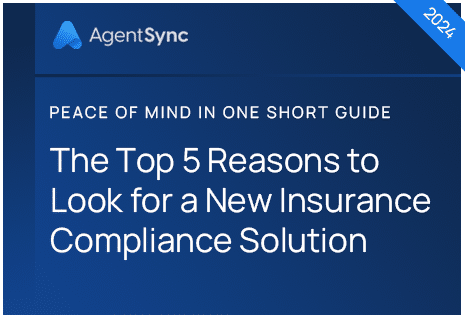

How’s your company managing producer, adjuster, and broker-dealer compliance today? Are you happy with the situation, or could it be better? And what would it take to nudge decisionmakers toward taking action on finding a new compliance solution?
Across the insurance industry, agencies, carriers, and MGAs/MGUs are managing license compliance in a surprisingly high number of inconsistent ways. From low-tech to high-tech, from in-house to outsourced, from manual to automated: There’s no single answer to the question of how to make sure every producer, adjuster, or broker-dealer is in good standing at all times.
There are, however, a handful of recurring themes we’ve seen that provoke insurance businesses to start making a change. While not an exhaustive list, these are the top five reasons insurance businesses are looking for a new compliance solution. If you recognize yourself or your company in these examples, chances are you’d really benefit from automated, modern insurance infrastructure.
1. Our current solution is paper, spreadsheets, and sticky notes
Not every insurance carrier or agency is suffering from a complete lack of technology. But you’d be surprised how many are! If your company’s compliance management system involves actual paper, sticky notes, PDFs, spreadsheets, and referencing multiple websites to cobble together an agent’s license status, you may be reaching a point where it’s just too manual to go on.
“In the not-too-distant past, when we were a single state business just focused on Texas, we were literally filling out the Texas Department of Insurance’s forms with Scantron and sending it in with a $10 check. That was a nightmare!”
AgentSync Manage Customer
Why this is a problem
Set aside, for one moment, the actual human toll of these extremely dated and manual processes. Forget about the fact that your company will be hard-pressed to attract and retain the next generation of insurance talent when it offers employees the chance to spend hours of their day cross-referencing state departments of insurance websites with your internal records.
All that aside, the compliance risk alone is a major problem. The more manual processes you have, the more chance for human error. The more paper-based your operations are, the more likely your expertise is to live only in the head of a single, long-time employee. These methods don’t future-proof your business or set you up for long-term growth.
Another very real problem with this method is that there’s no way to scale. Your business will be limited by how many licenses your current staff can manage at a time; and growing a distribution workforce will mean growing the number of people you have dedicated to keeping that distribution force in compliance.
Now, bring back the human element. Even if you wanted to keep doing things this way, will your business be able to attract the best and brightest for roles that are primarily focused on data entry and license verification? If you’re thinking, “Probably not,” then you can see why this is one of the top reasons businesses start to seek out new ways to manage their compliance.
2. We’re not getting what we’re paying for
This reason can take several forms:
- Maybe you’re paying one (or more) outside vendors to manage compliance but they’re not doing as good of a job as you’d like.
- Maybe you’re paying for expensive software that your staff can’t figure out how to use, so they simply don’t.
- Maybe you’ve got a supposedly high-tech solution, but it relies on data that someone at your company has to enter themselves, making the technology more manual than automated.
Whatever the specifics, if you’re paying for compliance and not actually getting compliance, there’s an issue.
“When I started, we had other outside companies managing licenses and renewals for us. In multiple cases, licenses on their renewal docket were about to lapse. It was extremely frustrating to be paying them money and still have to wonder if things were slipping through the cracks, or to incur late fees, despite already paying someone to take care of it.”
AgentSync Manage with Autopilot Customer
Why this is a problem
If your company’s like most, money doesn’t grow on trees. Companies are always looking for places to cut costs, and if you’re not careful, you’ll be back to managing compliance by hand because the expensive “solution” you’ve got isn’t really solving the problem.
And it’s not just wasting money that’s the issue: Companies in this situation are putting themselves at risk by outsourcing compliance to a third party that doesn’t have producer license management completely dialed in. You’re also creating a frustrating experience for employees because someone has to oversee the vendor’s work – which often takes almost as much time as if the person just did it all themselves.
If you’re paying for something and not getting the value, it’s only a matter of time before someone decides you don’t need to be paying for it at all! We’ve encountered lots of customers in this situation who’ve decided to proactively seek out a better solution (one that does a better job, while saving them money) before their company suffers the inevitable negative consequences of their current “solution.” Problems like regulatory actions or fines for noncompliance, losing staff to companies that make their jobs easier, or suffering a compliance management setback when leadership decides to cut the excessive line item.
3. We’re planning to grow our distribution channel, but there’s no way our current staff can support that goal
Lots of insurance businesses have a robust sales force, but the same isn’t true about their compliance staff. Often, even the largest insurance agencies and carriers have only a few people managing compliance, with the help of some legacy technology, and possibly some outsourced vendors.
Whatever the case at your business, if you’ve got people managing compliance for all of your producers, adjusters, or dually licensed broker dealers manually (or, if not manually, with less efficient technology), that’s a roadblock to your growth. It’s also important to remember the difference between growing and scaling. The former may bring in more business, but comes along with increased headcount or other operating expenses necessary to manage a larger distribution channel. The latter is the ability to grow revenue at a pace that doesn’t make operating expenses balloon at the same time.
“We knew as we continued to grow, our small team would not be able to handle the volume of licenses that would be put on our plate.”
“It became very clear that our current workflow of managing the agency appointment process just wasn’t scalable and sustainable.”
“We decided it was too big of an ask, especially of our two-person compliance team at the time, to manually manage appointments and licensing, and keeping track of 50 state regulations on these things.”
AgentSync Manage Customers
Why this is a problem
If you’re looking to grow your distribution channel, whether that’s permanently, or during a specific time like a catastrophic event when you have to quickly onboard more licensed insurance adjusters, the size of your license management team is often a limiting factor.
Not having the staff to take care of an influx of license applications, state appointments, or ongoing renewals and license management opens the door for one or more of the following:
- Staff get burned out from the workload and become more error-prone, or even leave the company entirely.
- Staff cut corners to save time, which creates compliance risk.
- The company has no choice but to bring on more compliance staff (or even just temporary employees) to support more producers, adjusters, or broker-dealers.
These consequences create financial and reputational risks that can negate the positive impacts of having a larger distribution workforce. That’s why we often see that when a company has ambitious growth goals and is also tasked with keeping costs down, it’s a great time to consider how automated technology solutions can come into play.
4. Our staff expects a certain level of technology and what we’re doing isn’t cutting it
As the insurance workforce of today hurls toward retirement age, we’re seeing a mass exodus from the industry that’s taking with it nearly everyone who accepts the old way of doing things as normal. To try to replace this rapidly retiring workforce, insurance carriers and agencies have to make themselves appealing to a younger generation: a generation of digital natives who’ve grown up expecting everything to function like Amazon and Netflix.
These younger potential insurance employees aren’t going to be satisfied when they learn that their job involves a lot of data entry and re-entry, and they’re not equipped with advanced technology to make those jobs easier. There’s no two ways about it: Insurance businesses that prioritize the user experience – not only for internal compliance staff but also for agents, adjusters, and even their up-and-downstream distribution channel partners – are going to have a strong competitive advantage.
“Everything about our company is very tech-driven. Our employees are used to a certain level of quality of tech products that we use on a daily basis. AgentSync was the only solution we saw that fit in with that.”
AgentSync Manage Customer
Why this is a problem
As much as we like to talk about a future powered by artificial intelligence, real, live human insurance industry staff aren’t going to be replaced by robotic agents any time soon. Until that day comes (which we hope is never), the industry will always need people to fill the roles of licensed agents, customer service representatives, claims adjusters, actuaries, and underwriters – just to name a few.
It’s an unavoidable fact that these roles will rest entirely on a younger generation in the near future, as long as the industry has what it takes to attract them. And while there’s debate over whether things like ping pong tables and fancy coffee will entice younger millennials and Gen Zers into insurance offices, there’s no question that dated technology and cumbersome business practices will drive them away.
5. We had a compliance close-call and realized we had to do something different
Insurance compliance software may feel expensive, but it’s nothing compared to the kinds of penalties and fines an insurance carrier or agency can be slapped with if they’re found to be selling policies, paying commission, or conducting other highly regulated activities out of compliance.
Sometimes, it takes a close-call for an organization to prioritize ongoing compliance. Other times, the realization strikes before there’s any real danger. Either way, insurance businesses often have a wake-up call, a point when they realize they’re playing with regulatory fire by not being completely on top of producer compliance.
“Some states have some pretty big fines if you’re not compliant. The way we look at it is, if we were fined just once by one of those states, it would be more than the cost of AgentSync.”
AgentSync Manage Customer
Why this is a problem
This is an easy one: No company wants to be held up as an example of what not to do!
Compliance violations cause financial harm, reputational harm, and have consequences that can reach far into the future if not properly addressed. No one wants to sell products for “that insurance company” that just made headlines for something unsavory. And forget about attracting the next generation of talent if an applicant googles the company’s name and finds headlines about compliance violations and penalties.
Even just a compliance close-call is too close for comfort, and enough of an issue to make insurance carriers and agencies take action. The best way to avoid regulatory hot water in the insurance industry is to implement strategies that make compliance nearly fool-proof. Luckily, the same strategies can also address other issues that likely exist within a company that goes through a compliance fire drill. Because, let’s face it, if a company’s having compliance close-calls, they’re likely suffering from other issues that’d best be solved by upgrading their producer license management.
Five problems, one solution
These five issues represent in large part why people go looking for a new insurance compliance solution to begin with. We’ve seen them over and over again, and thankfully, we’ve seen companies come out the other side with great results when they adopt AgentSync.
AgentSync is the modern producer compliance management system that takes producer onboarding from months to days, makes Just-inTime appointments effortless, costs less than many other options, and provides extensive insight into the status of any producers, adjusters, or dually licensed broker-dealers in your distribution channel.
See how your insurance business can solve compliance management once and for all with AgentSync.

